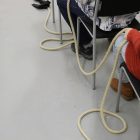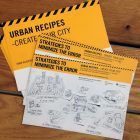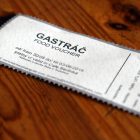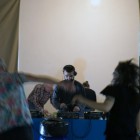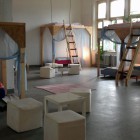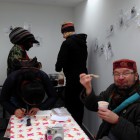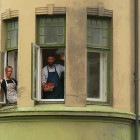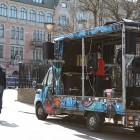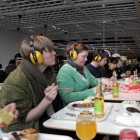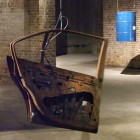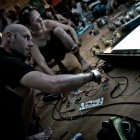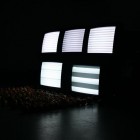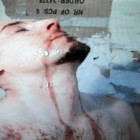Performance
Outsider in the North
How to catalog collaborative practices in the artistic context? If we understand that such practices emerge from an interest in the social, we find a type of art with a functionality and an interest to influence contexts outside the implicit; Being able to see the definition of Outsider as an instrumentalization capable of visualizing a perspective outside of the established; Representing just the possibility of modification, transformation and understanding within parameters that can contribute to encourage an extended social change beyond a project itself. As an insiders' outsider of the society. We decided to label the name of "Outsider" on top of a flag where the emblem of a construction company was located. The idea behind is to find the metaphorical physical solution of combining the definition of "Outsider", on top of an "Insider" emblem (da term that can be defined when dealing with a logo of a company that continues in the neo-capitalist processes of our society). The flag has the property of being able to be placed on a mast in a static way as well as being able to be carried by one or several people, with the possibility to mark an action carried out within a context.Insubordination of bodies
strategies to minimize the error
Artist menu
morning glory
"More than supra/ a draft prepared for failure" or more populary called "Morning Glory" is community related project that took form through a series of morning activities where we invited the audience to dance and have breakfast before starting the working day. Following the idea of creating a social space outside of consumption, where people could meet, experience, undertake an activity without need of money, we re-appropriate our self of a popular phenomenon of the breakfast club/ morning glory. These early morning events took place during the whole duration of the Triennial (twice a week/ 7 events). Free-form dance exercise, through listening to electronic music stimulated by local DJ curated by @Dot followed by breakfast.
S.O.S. Self Organized Systems, 2nd Tbilisi Triennial, October 2015
photo: Sandro Sulaberidze, Martinka Bobrikova
Bed & Breakfast
Bed & breakfast is another event of Kitchen Dialogues project, that took place in MeetFactory in collaboration with the 2015 Prague Quadrennial. Creating a social and cultural environment in our 100 square meter studio with modules/bedrooms built with recycled wood made it unique, warm and cosy, without forgetting all modern amenities. We offered accomodation to registred guests (max 12 per night) between 18th and 28th of june free of charge. During 9 days we have hosted a total of 59 guests that stayed between 1night and 1week of period each. We had the pleasure to accomodate guests from all around europe and oversees (israel, france, spain, lebanon, costa rica, czech republic, slovakia, sweden, norway, usa, germany, croatia, poland, uk, netherlands, slovenia, hungary, estonia, belgium, portugal, brazil etc).
more about the project on: http://kitchendialogues.com/
Do It YourSelf
Kitchen dialogues come from the idea of lounging around the kitchen outside of the consumption system through the alternative of creating various social interactions. The project aims to change consumer sensory intellectual concept of overproduction of food from supermarkets. Apart of that, we also like to focus on another aspect of the project, which involves transport/ smuggling of waste though, Europe. Not only we personally hunt the food in the local dumpsters, but we also move the food from place to place to offer to different audience variety of products not possible to gather in the that place. The formula we seek in Kitchen dialogues is that people can taste "the problem of surplus".
The project has as a reference “Food” of Gordon Matta-Clark, Rirkrit Tiravanija relational works, Dieter Roth, “Eat Art” of Daniel Spoerri, “Food Cultura” by Antonio Miralda or Filippo Tommaso Marinetti and Fillia's “Manifesto of Futurist Cooking”.
The exhibition is part of a larger project that has taken part and form in many different way around Europe and Asia. shown at Trailer gallery in Umeå, Sweden in march 2015.
Kitchen Dialogues
a series of environmental actions in the kitchen
This project aims to change consumer sensory intellectual concept of overproduction of food from supermarkets. In this occasion we will present food series of environmental actions in the kitchen around the theme of food surplus. We are interested in investigating the social changes among the common home environment meeting place called domestic kitchen and the meeting around the industrial kitchen in relation to the consumption of food surplus.
This private kitchen is a hybrid between being a guest in a dinner party and a restaurant. The shared experience of a set menu gives people common ground, and naturally the novelty factor is a conversation starter - it struck me as a comfortable cross between site specific theatre where you are not exactly sure what is going to happen, and a nice home party.
The private restaurant was located in Trondheim as a part of the exhibition CONSTANT. DEACY. organized by Rake visningrum. Private restaurant/ home setting was build by Heim og land arkitekter and took place in Elgesetergate 30b between 5th October and 31th October 2013. Elgesetergate 30b is an old abandoned apartment building which is now going to be demolished.
Kitchen Dialogues is an ongoing nomad project. go to the blog HERE
The Protester
This sound documentation presents an urban intervention, which took place in Malmö on the 29th of March, 2012, between 12pm -2pm.
Through a powerful sound system installed in a danish van used for demonstration in Copenhagen, we drove through the city projecting the sound of a crowd. “The Protest” started in Möllevångstorget and proceeded towards Triangeln, Föreningsgatan, Amiralsgatan and then surrounded the old town with 2 breaks at Stortorget and Gustav Adolfs Torg with a final stop in Triangeln.
The installation presents 8 sound tracks of documentation recorded during the event. The first 5 tracks, in chronological order, were recorded during the first 20 minutes of walking from Möllevångstorget to Triangeln. The next 3 tracks refer to the part between the breaks at Stortorget and Gustav Adolfs Torg.
Utopic topic
Utopic topic, is a context specific performance, whose purpose is to create through disinhibition, the interruption of the automated human behavior in private spaces encouraged to binge. In this context, the experience of disinhibition we carried Contemplating, perceives the confrontation as a tool for compulsive consumption through aesthetic experience. In this way we create new sensory experiences in private spaces, which appear as public spaces, to attract the families to shop in comfort.
Ikea Malmö, december 2011.
RAINFOREST IV
“It occurred to me that one should reverse the application of loudspeakers so that they would not merely reproduce sound but actually produce sound. The idea is based on taking any number of fixed materials and transmitting sound through them; through their resonance frequencies they become a new instrument”, wrote Tudor.
This is newly interpreted work under the direction of Canadian composer, sound artist and Tudor specialist Matt Rogalsky, of American musician and composer David Tudor, which was created in 1973.
Found, converted or self-made objects are arranged freely around the room. Transducers on the objects cause the items to emit sounds. Resulting is an abundant, accessible “rainforest” of sounds.
partecipating artists: Martinka Bobrikova, Oscar de Carmen, Seth Davis, Cecilia Jonsson, Joonas Siren, Lauri Wuolio, Flopper (Christian Mastrup), Signe Lidén, Jonas Olsen and Thomas Wochnik
exhibited at Singuhr Hoergalerie
photo copyrights: singuhr / roman märz 2011
f+e=n
Is an audio-visual performance based in the audiovisual installation “E”, where we create an open hardware by the use of the basic 3rd generation hardware, capable of process into sound the energy contained in fruits and vegetables, discarded by supermarkets, through an electrochemical reaction.
Shows the electrochemical reaction, which is generated by inserting two different metallic objects, copper and zinc, in each of the fruit that is in the installation. These fruits, connected in series, produce a small amount of electricity that is transformed through various integrated circuits to sound frequency, which are displayed on TVs located in the room.
By synthesis of analog and digital video, hardware (video synthesizer) and free software (PureData) previously designed and built for live audiovisual installation Fruit+emotion=noise, artists create an audiovisual composition based on the law of conservation of energy, the first law of thermodynamics, which states that energy can neither be created nor destroyed, only can be transformed.
F+E=N is a collaborative project between Martinka Bobrikova & Oscar de Carmen and Victor Mazon.
E
Our art work incribes in the conceptual and / or aesthetic field within artistic practices, somewhere between art and social activism, helping to develop critical devices that help us to socialize with the problems that exist in our society with rejected products by current models of production and consumption, which produces a new terrain.
We create an open hardware by the use of the basic 3rd generation hardware, capable of process into sound the energy contained in fruits and vegetables, discarded by supermarkets, through an electrochemical reaction.
- Protest against current patterns of production and consumption, providing new critical devices.
- Evaluate the environmental impact generated in the field of waste management.
- Finds a second use for the fruits and vegetables which are discarded by supermarkets because of their color or shape and is not attractive for sale to customers.
- Visualize the sound of the energy given out by fruits and vegetables discarded by the supermarkets.
- Shows the electrochemical reaction, which is generated by inserting two different metallic objects, copper and zinc, in each of the fruit that is in the installation. These fruits, connected in series, produce a small amount of electricity that is transformed through various integrated circuits to sound frequency, which are displayed on TVs located in the room.
Technical rider: Victor Mazon
Noise and Fruit
Noise and Fruit comes up from the need to think as an individual subject on the problems of current patterns of production and consumption. This body action is a specific device of criticism and protest, which appropriates any iconographic sign of the culinary culture, reinterpreting and altering it, setting new imaginary with fruit and vegetables at optimum quality, which has been considered as perishable by supermarkets .
The action takes place in an interior space of 5 x 3 meters, not accesseble by the public, equipped with lighting and audio systems. There is a system of devices of pick ups connected to the performer and to the food and knives, used in the performance, which allows the performer to create analog sounds. Located in each esterior corner of this space, there is a small LCD screen and speakers so the viewer can see and hear in real time what is happening in the interior space, being him who builts his own narratives.
Shown in June 2009, the Faculty of Fine Arts Cuenca.Cuenca. Spain.

